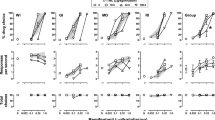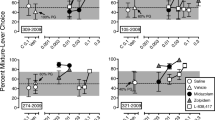Abstract
Rationale
Cocaine and opioids are often co-abused. As yet, however, there is no clear evidence that the drugs interact to make the mixture a more effective reinforcer.
Objective
The present study examined the relative reinforcing potency and maximum effectiveness of the cocaine–opioid combination in monkeys given a choice between cocaine–opioid mixtures and the single-component drugs.
Method
Rhesus monkeys were allowed to choose between injections of cocaine (100 μg/kg/inj) and other doses of cocaine (10–560 μg/kg/inj) or remifentanil (0.03–3.0 μg/kg/inj). A dose-addition model was used to select dose combinations for mixtures of cocaine and remifentanil predicted to be equivalent to 100 μg/kg/inj of cocaine in reinforcing effect if the drugs were additive. The monkeys were then allowed to choose between (a) cocaine and mixtures predicted to be equivalent to 100 μg/kg/inj of cocaine, (b) increasing doses of the mixtures and the single-component drugs, and (c) cocaine or remifentanil at doses that were in the highest safe range.
Results
Generally, monkeys preferred the mixtures over 100 μg/kg/inj of cocaine, evidence for superadditivity. However, preferences for the mixture ceased when relatively high doses of single-component drugs were offered as alternatives. When doses within the mixture were raised and offered with relatively high doses of the single drugs, there was no clear preference for either option. The highest dose of remifentanil was chosen over the highest dose of cocaine by all monkeys.
Conclusion
The current results indicate that cocaine–opioid combinations can be super-additive in terms of potency, but are not, at maximum, more effective than the single-component drugs.




Similar content being viewed by others
References
Arnold JM, Roberts DCS (1997) A critique of fixed and progressive ratio schedules used to examine the neural substrates of drug reinforcement. Pharmacol Biochem Behav 57:441–447
Bickel WK, DeGrandpre RJ, Higgins ST (1993) Behavioral economics: a novel experimental approach to the study of drug dependence. Drug Alcohol Depend 33:173–192
Coffin PO, Galea S, Ahem J, Leon AC, Vlahov D, Tardiff K (2003) Opiates, cocaine and alcohol combinations in accidental drug overdose deaths in New York City, 1990-1998. Addiction 98:739–747
Comer SD, Ashworth JB, Foltin RW, Johanson CE, Zacny JP, Walsh SL (2008) The role of human drug self-administration procedures in the development of medications. Drug Alcohol Depend 96:1–15
Downey KK, Helmus TC, Schuster CR (2000) Treatment of heroin-dependent polydrug abusers with contingency management and buprenorphine maintenance. Exp Clin Psychopharmacol 8:176–184
Duvauchelle CL, Sapoznik T, Kornetsky C (1998) The synergistic effects of combining cocaine and heroin (“speedball”) using a progressive-ratio schedule of reinforcement. Pharmacol Biochem Behav 61:297–302
Foltin RW, Fischman MW (1992) The cardiovascular and subjective effects of intravenous cocaine and morphine combinations in humans. J Pharmacol Exp Ther 261:623–632
Grella CE, Anglin MD, Wugalter SE (1995) Cocaine and crack use and HIV risk behaviors among high-risk methadone maintenance clients. Drug Alcohol Depend 37:15–21
Hursh SR (1984) Behavioral economics. J Exp Anal Behav 42:435–452
Hursh SR (1993) Behavioral economics of drug self-administration: an introduction. Drug Alcohol Depend 33:165–172
Hursh SR, Silberburg A (2008) Economic demand and essential value. Psych Rev 115:186–198
Joe GW, Simpson DD (1995) HIV risks, gender, and cocaine use among opiate users. Drug Alcohol Depend 37:23–28
Johanson CE, Schuster CR (1975) A choice procedure for drug reinforcers: cocaine and methylphenidate in the rhesus monkey. J Pharmacol Exp Ther 193:676–688
Koffarnus MN, Woods JH (2008) Quantification of drug choice with the generalized matching law in rhesus monkeys. J Exp Anal Behav 89:209–224
Kosten TR, Rounsaville BJ, Kleber HD (1988) Antecedents and consequences of cocaine abuse among opioid addicts. A 2.5-year follow-up. J Nerv Ment Dis 176:176–181
Leri F, Bruneau J, Stewart J (2003) Understanding polydrug use: review of heroin and cocaine co-use. Addiction 98:7–22
Mattox AJ, Thompson SS, Carroll ME (1997) Smoked heroin and cocaine base (speedball) combinations in rhesus monkeys. Exp Clin Psychopharmcol 5:113–118
Negus S (2005) Interactions between the reinforcing effects of cocaine and heroin in a drug-vs-food choice procedure in rhesus monkeys: a dose-addition analysis. Psychopharm 180:115–124
Ochoa KC, Hahn JA, Seal KH, Moss AR (2001) Overdosing among young injection drug users in San Francisco. Addict Behav 26:453–460
Perez de los Cobos J, Turjols J, Ribalta E, Casas M (1997) Cocaine use immediately prior to entry in an inpatient heroin detoxification unit as a predictor of discharges against medical advice. Am J Drug Alcohol Abuse 23:267–279
Preston KL, Sullivan JT, Strain EC, Bigelow GE (1996) Enhancement of cocaine’s abuse liability in methadone maintenance patients. Psychopharm 123:15–25
Ranaldi R, Munn E (1998) Polydrug self-administration in rats: cocaine-heroin is more rewarding than cocaine-alone. Neuro Report 9:2463–2466
Rowlett JK (2000) A labor-supply analysis of cocaine self-administration under progressive-ratio schedules: antecedents, methodologies, and perspectives. Psychopharm 153:1–16
Rowlett JK, Woolverton WL (1997) Self-administration of cocaine and heroin combinations by rhesus monkeys responding under a progressive-ratio schedule. Psychopharm 133:363–371
Rowlett JK, Rodefer JS, Spealman RD (2005) Self-administration of cocaine-opioid combinations by rhesus monkeys: evaluation of the role of μ receptor efficacy using labor supply analysis. J Pharmacol Exp Ther 312:1289–1287
Rowlett JK, Platt DM, Yao WD, Spealman RD (2007) Modulation of heroin and cocaine self-administration by dopamine D1- and D2-like receptor agonists in rhesus monkeys. J Pharmacol Exp Ther 321:1135–1143
Stafford D, LeSage MG, Glowa JR (1998) Progressive-ratio schedules of drug delivery in the analysis of drug self-administration: a review. Psychopharm 139:169–184
Tallarida RJ (2000) Drug synergism and dose-effect data analysis. Chapman & Hall/CRC, Boca Raton
Wade-Galuska T, Winger G, Woods JH (2007) A behavioral economic analysis of cocaine and remifentanil self-administration in rhesus monkeys. Psychopharm 194:563–572
Wang NS, Brown VL, Grabowski J, Meisch RA (2001) Reinforcement by orally delivered methadone, cocaine, and methadone-cocaine combinations in rhesus monkeys: are the combinations better reinforcers? Psychopharm 156:63–72
Ward SJ, Morgan D, Roberts DCS (2005) Comparison of the reinforcing effects of cocaine and cocaine/heroin combinations under progressive ratio and choice schedules in rats. Neuropsychopharm 30:286–295
Williamson A, Darke S, Ross J, Teeson M (2006) The effect of persistence of cocaine use on 12-month outcomes for the treatment of heroin dependence. Drug Alcohol Depend 81:293–300
Winger G, Galuska CM, Hursh SR, Woods JH (2006) Relative reinforcing effects of cocaine, remifentanil, and their combination in rhesus monkeys. J Pharmacol Exp Ther 318:223–229
Woolverton WL (1987) Analysis of drug interactions in behavioral pharmacology. In: Thompson T, Dews PB, Barrett JE (eds) Neurobehavioral Pharmacology. Lawrence Erlbaum Associates, Hillsdale, NJ, pp 275–302
Woolverton WL, Johanson CE (1984) Preference in rhesus monkeys given a choice between cocaine and d, l-cathinone. J Exp Anal Behav 31:35–43
Woolverton WL, Wang Z (2009) Self-administration of cocaine-pentobarbital mixtures by rhesus monkeys. Drug Alcohol Depend 100:272–276
Woolverton WL, Myerson J, Green L (2007) Delay discounting of cocaine by rhesus monkeys. Exp Clin Psychopharmacol 15:238–244
Woolverton WL, Wang Z, Vasterling T, Tallarida R (2008) Self-administration of cocaine-remifentanil mixtures by monkeys: an isobolographic analysis. Psychopharm 198:387–394
Acknowledgments
The authors have no conflicts of interest to disclose. This research was supported by National Institute on Drug Abuse grant R01 DA-019471 to W.L.W. We gratefully acknowledge Steven Ross for his technical assistance.
Author information
Authors and Affiliations
Corresponding author
Rights and permissions
About this article
Cite this article
Freeman, K.B., Woolverton, W.L. Self-administration of cocaine and remifentanil by monkeys: choice between single drugs and mixtures. Psychopharmacology 215, 281–290 (2011). https://doi.org/10.1007/s00213-010-2131-1
Received:
Accepted:
Published:
Issue Date:
DOI: https://doi.org/10.1007/s00213-010-2131-1




